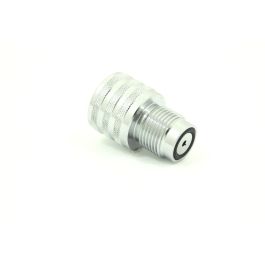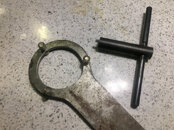OK finally had some time to make some special tools and get the Porpoise CA-1 back together!
As outlined earlier. the Porpoise first stage can trace its heritage back to a 1940's CIG gas welding oxygen regulator, and as such had an Imperial G5/8" BSP bullnose gas connection.
The original twin tanks that came with this set were repurposed WWII LP oxygen tanks with a rated WP of 1800psi (125BAR)
They seemed in very good condition visually, but I was able to get them hydro tested at 2500psi (175BAR) and then filled to 125BAR.
I wanted to decant a modern tank into a lower pressure unit for testing as NO local dive shop was ever going to fill a WWII twin set!
I discovered Narked@90 sell a Bullnose G5/8" to DIN adaptor so could connect the Porpoise to a modern cylinder filled to 125BAR.
DIN 200/300 bar male to Female Bullnose MALE 200/300 DIN TO G5/8 UK FEMALE BULLNOSE - Worldwide Shipping Available

www.narkedat90.com
I made up two tools to service and tune the CA-1 (part # refers to the HDS A-P Porpoise bible listed earlier)
First was a large ring spanner to remove the first stage #18 Regulator Body Top without damage to the chrome or soft brass.
A repurposed cycle spanner I got for $2 at a local trash'n'treasure market with three extra lugs added proved ideal.
Second was a toothed tube spanner to remove and replace #9 HP Valve Chamber... quite tricky to snug it down properly without this tool. Again a repurposed cycle tool.
Another good thing about a SCUBA regulator having a heritage with gas welding equipment is that there are plenty of connectors available to rig up a IP gauge. So I used an oxygen hose fitting on the end of a repurposed LP inflator hose to connect my IP gauge.
With a Y connector you can run both the second stage and an IP gauge...
luxury!
Gas hoses from BOC include a range of acetylene, oxygen, LPG gas hoses and fittings to suit your gas applications. Buy your gas hoses and fittings online from BOC today.
www.boc.com.au
The Porpoise first stage has an OPV that pops at 120psi, so I set the IP at 100psi... when first setting up that roughly corresponds to three threads showing above the IP spring adjust screw locknut.
Having gained 100psi IP I then set about tuning the second stage.
There is no purge valve and none of the usual cracking point adjustments on a CA-1.
Once you have the diaphragm installed, any adjustments are made via bending #15 Lever Fulcrum a little at a time.
I can now see why the LP valve assembly drops out very quickly via a knurled retention ring, many disassembly and reassembly cycles needed to get it right!
SO, finally I have a working CA-1... it still needs some final tuning from local Porpoise guru Tony Gregory as WOB seems very high compared to say a Royal Aqua Master double hose which it was eventually to dominate in the market.
It has been quite an effort to get here... hope you enjoy my Porpoise journey in pictures.













